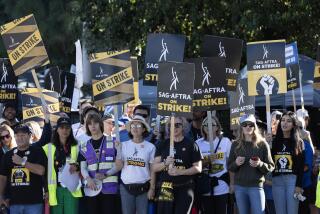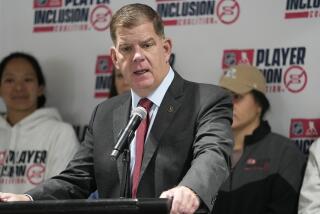Gap Widening in NHL Talks : Analysis: Each side sticking to its plan for helping small-market clubs, stabilizing costs.
- Share via
Nearly seven hours of talks Tuesday between the NHL Players Assn. and the league produced an agreement to meet again today in New York. That accord--and where to order out for lunch--were the only common ground they reached in their longest bargaining session to date.
No areas of potential compromise have emerged from the 12 hours of discussion in the last two meetings. If anything, the gap has widened, as each side adheres to its approach to stabilizing costs and helping small-market clubs survive.
“Some serious philosophical differences have to be resolved if we’re going to have a deal,” said Bob Goodenow, executive director of the players association.
Barring sudden and major concessions from either side, it’s unlikely a new agreement will be in place by Oct. 1, when the season is scheduled to open.
The players, who went all of last season without a contract, have said they are willing to do so again if necessary. NHL Commissioner Gary Bettman has already gotten authorization from owners to invoke a lockout, although he has repeatedly refused to say how seriously he is considering that option.
The league on Tuesday rejected a proposal by the players in which a 5% levy would be imposed on clubs’ revenues and the proceeds disbursed to clubs in small markets. Owners remain fixed on salary controls, as embodied in their plan to set a payroll limit and penalize clubs that exceed that figure. The money would go to small-market teams.
“They’re hell-bent for leather on having a salary cap,” a source among the players said.
Sources said owners scoffed at the union’s claim that its levy on revenues would raise $35 million. Their estimate was $20 million, which they deemed insufficient to help clubs such as Winnipeg and Quebec.
The owners’ last proposal, rejected last week by players, would also abolish arbitration--which the players want to retain--and relax restrictions on free agency. However, according to that plan, clubs would retain the right to match offers made to free agents. Players want unfettered free agency.
Led by the hard-bargaining Bettman, owners clearly maintain the upper hand. By unilaterally imposing 19 conditions--including the reduction of game rosters from 18 skaters to 17, forcing players to pay their own way to training camp and obligating those who earn more than $350,000 to pay their own medical insurance--Bettman cleverly gave himself a handful of bargaining chips to play later, when he needs to pressure players into making significant concessions.
He can now, in the customary give-and-take of negotiations, relent on some of those points and appear to be giving something up while actually coming out even. For example, he will probably agree to restore rosters to 18 skaters. He appears magnanimous, when all that will do is give players exactly what they had before--yet it will make them feel they avoided losing jobs. He can also give back the training-camp expense money, with the same effect.
Players have no intention of striking. It would do them no good economically or in a public relations sense. If Bettman locks them out, he and the owners would be cast as the bad guys, and that’s how the players want it.
Bettman will use the implied threat of a lockout to weaken the players’ resolve. And there are some cracks in their unity on the point of a salary cap for rookies, and he will probably exploit that opening. He’s a tough negotiator. Ask the league’s on-ice officials. He called their bluff when they threatened a walkout a year ago, and in the end, he got the four-year agreement he wanted.
Bettman will want a long agreement with the players too, in order to avoid this mess again for several years and to help clubs project their expenses. Players, who have seen the salary average rise from $201,000 in the 1988-89 season to $520,000 last season, will probably want a shorter deal so they can cash in if salaries and league revenues continue their strong growth.
More to Read
Go beyond the scoreboard
Get the latest on L.A.'s teams in the daily Sports Report newsletter.
You may occasionally receive promotional content from the Los Angeles Times.







